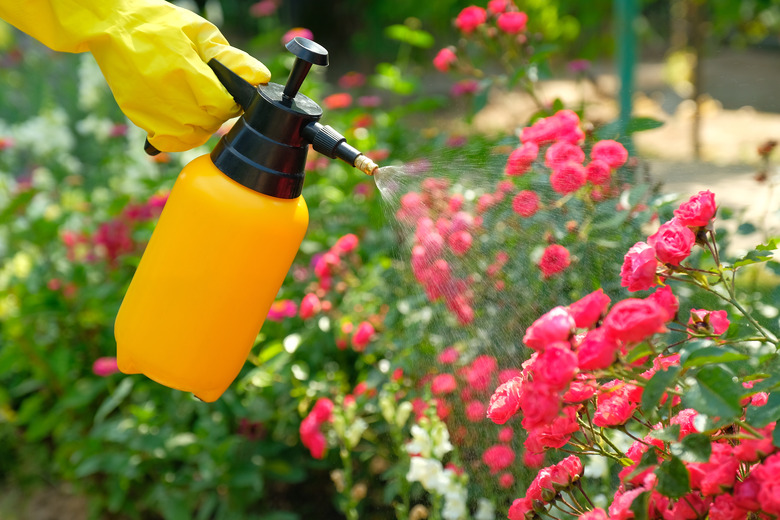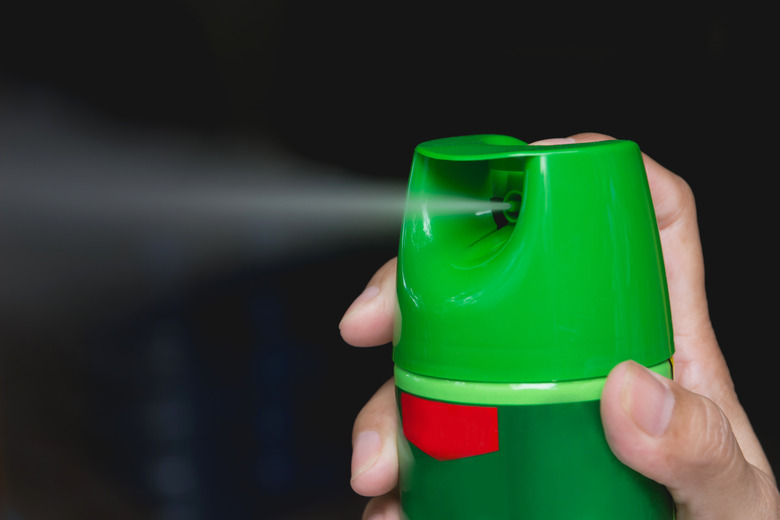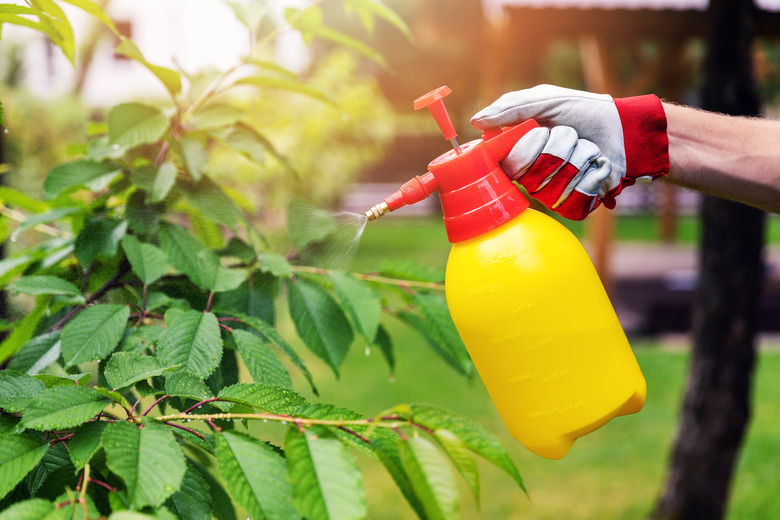Is It Safe To Use Pesticides? Here's What You Should Know
We may receive a commission on purchases made from links.
Chemicals used for pest control run the gamut from relatively harmless household substances to toxins that may harm humans, wildlife, and the environment in general. If applied specifically as directed, many toxic chemicals used as pesticides are considered effective and allowable treatments by the Environmental Protection Agency (EPA), while misusing those same formulations is cause for serious concern. Even some "safe" pesticides may have a level of toxicity that could be harmful if they are used improperly.
Whether it's safe to use pesticides is the ultimate question regarding their use — so much so that several are the constant subject of lawsuits and of debates on whether long-term pesticide exposure is detrimental to human health. For best results with any pest control issue, look for the most natural pesticide available for the problem. Always read the warnings on the label before use to determine whether the substance could be harmful in any way. For pesticides used outdoors, this includes reading up on what the substance does to the surrounding environment and the health risks for your family members.
Tip
It's safe to properly use pesticides that aren't toxic to humans or animals, but deciding what "safe" actually means when it comes to harsh chemicals is a bit more subjective. If the pesticide has a warning label with all kinds of health and environmental concerns listed, it's best to avoid using it.
Pesticides: More Than Bug Sprays
Pesticides: More Than Bug Sprays
While the word "pesticide" may call to mind a spray used to kill insects on contact, the term covers far more than that. A pesticide is any substance that kills, repels, or otherwise controls lifeforms that may be considered pests, going well beyond the realm of just insects. Common forms of pesticides include fungicides, herbicides, rodenticides, and even algaecides used to kill algae in bodies of water. For example, horticultural vinegar used to kill broadleaf weeds is an herbicide, which also makes it a pesticide under this terminology.
Sanitizers, germicides, and disinfectants are also forms of pest control called antimicrobial pesticides. These products are used in a number of ways to kill household germs. Any of these designated for use on or around food-preparation surfaces are generally safe, but they may be dangerous with the types of improper use noted on their warning labels.
Known Pest Control Toxins
Known Pest Control Toxins
Many readily available pesticides contain toxic chemicals, but those considered the most dangerous (like diazinon) are listed as "restricted use" by the EPA, which means only licensed applicators can legally use it in the United States. Paraquat used for weed control is one such example, as it is highly poisonous, entering the body through the skin or through inhalation. Pesticide poisoning causes nausea, dizziness, organ failure, or even death. The EPA even recommends discarding rather than washing clothes after liquid paraquat spills on the item.
Organophosphate pesticides, including glyphosate and chlorpyrifos, are under scrutiny for various health risks. Glyphosate, an active ingredient in Roundup, is the subject of numerous lawsuits, as some studies have linked it to an increased risk of developing non-Hodgkin lymphoma. Regions in more than 12 countries have banned or restricted its use.
Chlorpyrifos, the most widely used pesticide on crop plants, is dangerous enough to be under constant review for banning by the EPA. Using it requires full protective clothing during application and then staying away from the area for up to five days. Exposure overstimulates the nervous system and in extreme cases may cause death, while prenatal exposure to chlorpyrifos may cause birth defects like neurodevelopmental issues. In 2018, the Ninth District Court of Appeals issued an order to ban the substance, but further hearings allowed it to stay on the market. In April 2021, a federal appeals court ruled again to ban the substance or require lower residue levels.
Is It Harmful?
Is It Harmful?
Aside from known toxic chemicals, the best way to determine if any specific pesticide is dangerous in any way is to fully read the label, noting both the active and inactive ingredients as well as the application instructions and warnings. Widely available pesticides have been tested extensively to determine any potential risks to human health and to the environment in general, so the product label must disclose any concerns.
If kids or pets play in your yard, reading the product label lets you know whether a flea and tick treatment used for lawns is actually a good idea, as some are dangerous. Any toxic chemicals capable of killing vast amounts of small insects may also poison pets, wildlife, or even children who enjoy sitting on the lawn. If the label says not to let animals or children in the yard for a day or two, consider skipping the product completely, opting instead for a more natural solution, such as nematodes.
Reduce Your Risks
Reduce Your Risks
No matter whether the pesticide is seemingly safe, avoid getting it anywhere near your face or in cuts. Wear full clothing coverage, gloves, and eye protection if the label says to do so. Avoid breathing in any treatment that emits a mist, spray, or fog. Unless the product label indicates the material is completely nontoxic and safe around foods, don't use the material on any item that may come in contact with foods, such as a cutting board. Keep all pesticide products well out of the reach of children and pets.
If you are hiring a pest control company for a major infestation, ask ahead of time what methods and chemicals will be used to eradicate the issue. Many foggers are highly toxic, and even plants and pet fish should be removed from the area ahead of the treatment date. For indoor and outdoor pest control services, ask the exterminator if the treated area needs to be avoided for a specific amount of time. Also ask if the treatment may kill species other than the targeted pest. If at all possible, ask for nontoxic control methods instead.
Consider the Environmental Consequences
Consider the Environmental Consequences
Many pesticides do more harm than good in the long run. Once again, key indicators of problematic pesticides are on the warning label. Any wording that says not to use it near waterways or storm drains, for instance, indicates the problem has a high enough toxicitaquatic life or poison the water.
Many chemicals used to kill pesky insects outdoors might also kill beneficial bugs, such as ladybugs and honeybees. Even applying lawn-based weed killers to plants, such as clover, has an affect on wildlife. Getting rid of clover gets rid of a food source for beneficial pollinators, such as honeybees.
Birds are also susceptible to harm. Herbicides and insecticides poison songbirds and other small birds that eat the treated insects and plant matter, while rodent poisons affect raptors, such as owls and hawks, that prey upon these creatures.
References
- National Institute of Environmental Health Sciences: Pesticides
- Centers for Disease Control and Prevention: Facts About Paraquat
- Environmental Protection Agency: Chlorpyrifos
- Chemical & Engineering News: Time's Up for Chlorpyrifos on Food in the US
- Harvard University: The Most Widely Used Pesticide, One Year Later
- Environmental Protection Agency: What are Antimicrobial Pesticides?
- National Library of Medicine: Exposure to Glyphosate-Based Herbicides and Risk for non-Hodgkin Lymphoma: A Meta-analysis and Supporting Evidence
- PBS News Hour: What You Need to Know About a Popular Weed Killer's Alleged Link to Cancer
- Baum Hedlund: Where is Glyphosate Banned?


